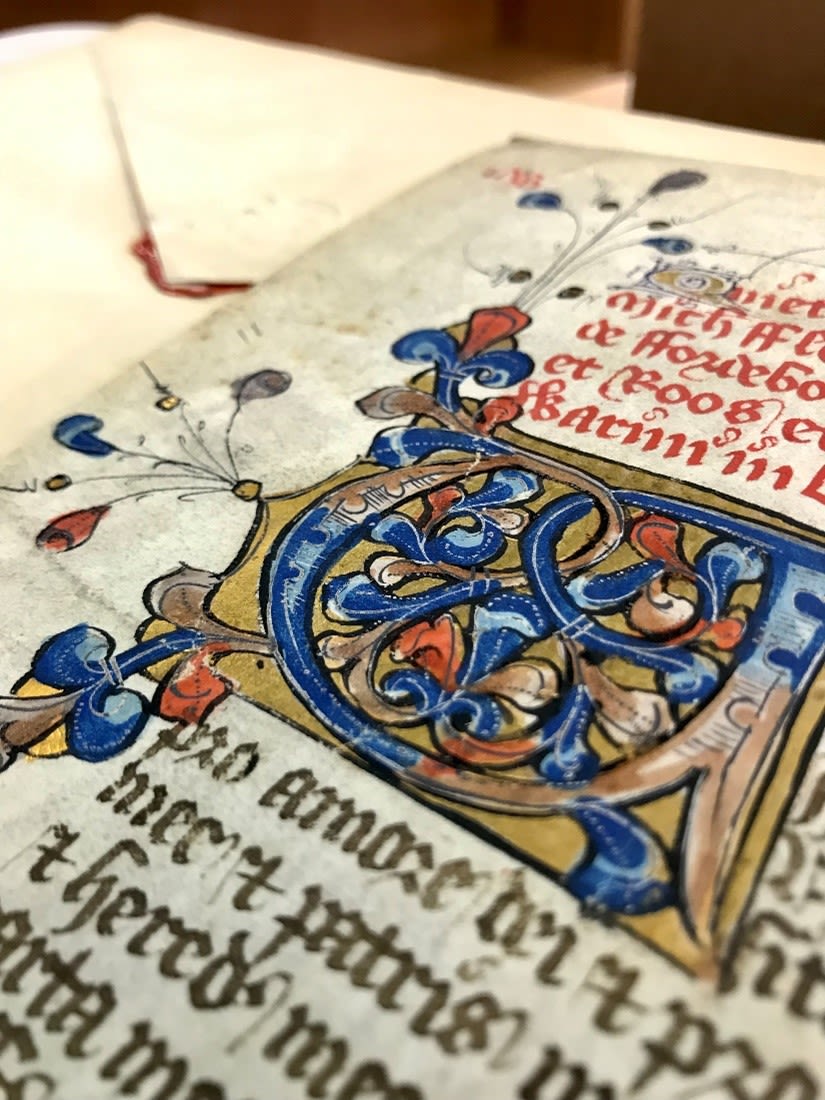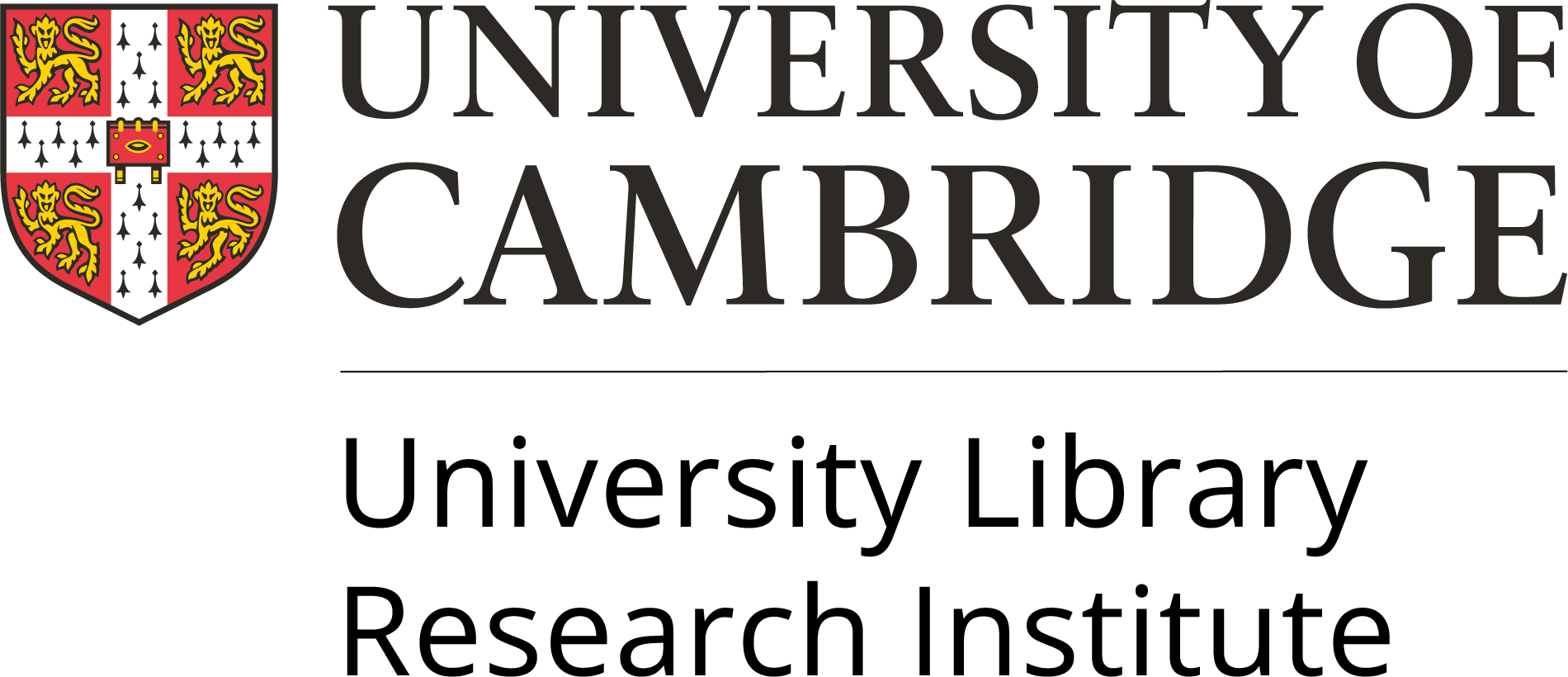Fragments of Medieval Manuscripts
Making a hidden collection
visible and available for research
Funded by
Fragmentarium,
the Swiss National Science Foundation,
the Aurelius Charitable Trust,
the Association for Manuscripts and Archives in Research Collections and
the National Manuscripts Conservation Trust

Cambridge University Library (CUL) is home to over 2,250 fragments of medieval manuscripts, divided between eighty collections of different sizes and subjects.
The fragments are remnants of once-complete handwritten books, bearing scraps of texts that were copied between the 8th and the 16th centuries in countries across western Europe. As such, they represent a significant - if imperfect - witness to the literate culture of the medieval world.
They also shed light on patterns of destruction and survival during both the medieval and early modern periods. Many of the fragments have been preserved only because the manuscripts from which they were taken were recycled for use in the binding and repair of other manuscripts or early printed books.
Many of the fragments, in fact, come from CUL's own early printed books and were removed and retained during their repair or rebinding in the late 19th and early 20th centuries. Some were also collected by Francis Jenkinson (University Librarian, 1889-1923) and bequeathed by him to the Library. Jenkinson was interested in the ephemeral in other contexts (notably the War Reserve collection) and played an instrumental role in preserving the fragments and fostering the study and description of them at CUL.
A century on, and supported by a portfolio of funding, a new initiative at CUL will continue Jenkinson's legacy by making this outstanding and varied collection more accessible to researchers through re-housing and cataloguing. It will also raise awareness of the richness and variety of the medieval manuscript fragments through selective digitisation, sharing some of the most interesting items freely with the world through the Cambridge Digital Library.

Francis Jenkinson (1853-1923), Cambridge University Librarian 1889-1923
Francis Jenkinson (1853-1923), Cambridge University Librarian 1889-1923
Re-housing
The project will re-house the entire collection of medieval manuscript fragments. This will provide safe and appropriate storage for these valuable and vulnerable survivals, and enable researchers to find and consult them safely and easily.
The last concerted attempt to deal with the collection of fragments took place during the 1910s, 1920s and 1930s. Much of the housing dates from that time, and comprises a range of different boxes, portfolio folders or envelopes. Some of these have deteriorated physically, and none meets modern-day archival standards. The fragments themselves have been kept loose within these containers, and are sometimes held together by scraps of paper and old paper-clips. This makes them vulnerable to damage or loss.
The fragments will be re-housed in custom-made four-flap folders, which will be grouped together by classmark into standard-sized boxes. All materials used will be acid-free and lignin-free. Each box will be clearly labelled and contain an inventory of its contents, together with advice about their condition and appropriate handling.

Re-housed fragments, CUL MS Add. 4404
Re-housed fragments, CUL MS Add. 4404
This part of the project is supported internally by CUL, as part of ongoing initiatives to re-house its collections.

Cataloguing
The project will produce detailed descriptions of the fragments, identifying their textual contents, recording information about their material characteristics, dating their production and documenting their provenance.
Little information has been available publicly about CUL's collections of medieval manuscript fragments. A few are significant in some way and are more widely known; for the rest, there is - at most - a brief handwritten description from decades ago. These unpublished descriptions have been formally accessioned into the University Archives and are now available for researchers to consult.
As part of the cataloguing process, the information in the unpublished descriptions is being collated alongside new information into a digital record. This can then accompany digital images on the Cambridge Digital Library, and form the basis of a dataset for use in an online catalogue of manuscripts that is planned for the future.
This part of the project is funded by Fragmentarium, Laboratory for Medieval Manuscript Fragments at the University of Fribourg (with funding from the Zeno Karl Schindler Foundation) and the Aurelius Charitable Trust.



Unpublished description of Add. 4406 by Basil Atkinson, c. 1920s-30s: UA ULIB 7/3/72/27
Unpublished description of Add. 4406 by Basil Atkinson, c. 1920s-30s: UA ULIB 7/3/72/27

Description in TEI / XML of Add. 4407(5) by Marie Turner
Description in TEI / XML of Add. 4407(5) by Marie Turner
Digitisation
High resolution digital photography will enable researchers to access the textual contents of the fragments and see their size, shape and condition in detail.
The photography of fragments is not always straightforward, however: standard approaches treat them as flat, two-dimensional objects, when they are often three-dimensional objects whose material form contains important evidence of their preservation and history. The project will also explore different approaches to the digitisation of fragments, experimenting creatively with non-destructive and non-invasive imaging in order to enhance researchers' understanding of medieval manuscript fragments' materiality, history and contents.
This part of the project is funded by the Swiss National Science Foundation and the Association for Manuscripts and Archives in Research Collections.

Conservation
One of the most important collections is a 19th-century guardbook (MS Add. 5963), which contains 68 manuscript fragments, most of which range in date from the 12th to the 14th century. These were gathered together to make a 'Catalogue of fragments from ancient manuscripts on vellum towards a history of writing', perhaps by John Bagford (1650/51-1716), an important early collector and dealer of fragments. One of a set of two volumes, and acquired for the University Library by Francis Jenkinson, it is an important witness to the gathering, selection and curation of fragments in antiquarian circles in the 18th and 19th centuries.

Handwritten frontispiece to guardbook of fragments, CUL MS Add. 5963
Handwritten frontispiece to guardbook of fragments, CUL MS Add. 5963
However, the guardbook is in very poor condition: the paper on which the fragments are mounted is brittle and often detached, torn or crumbling. It cannot be safely consulted by researchers and its continued deterioration puts the fragments at further risk of damage or loss.

Fragment of a noted Missal, 13th century, CUL MS Add. 5963(7)
Fragment of a noted Missal, 13th century, CUL MS Add. 5963(7)
The fragments in this volume will therefore be rehoused in a new, archival-standard guardbook, custom-made using acid-free materials. In this new guardbook, the fragments will be presented in the order in which they are currently found, together with any accompanying annotations and numbering, in order to preserve the evidence of their curation and arrangement. In addition, some of the fragments that have suffered damage will be conserved. The fragments in this volume will also be digitised.
This part of the project is being funded by the National Manuscripts Conservation Trust.
Impact
By adopting a multi-disciplinary approach - encompassing re-housing, cataloguing, digitisation and conservation - this project is securing the future of the University Library's collection of medieval manuscript fragments.
Embedding re-housing and conservation as part of this project guarantees the accessibility and availability of this collection for researchers to consult in person, and ensures that these fragile remnants may be safely stored, transported and consulted in our reading room.
The digital images and descriptions produced by the project will be published on the Cambridge University Digital Library (CUDL) and some may join the database on Fragmentarium.ms, an online hub for fragment studies, making the collections available to a global community of libraries, researchers, students and collectors.

Engage with medieval manuscript fragments
Follow our blog
Follow Cambridge University Library's Special Collections blog for project updates.
Tweet us
The project team also post regular updates on Twitter. Follow us at @theULSpecColl and use #CULfragments to share your thoughts!
Resources
View the fragments that have been digitised so far on Cambridge University Library's research output platform.
Project Team
Dr Marie Turner
Fragmentarium Fellow
Amelie Deblauwe
Project photographer
Jennifer Murray
Project conservator (2022-23)
Emma Nichols
Project conservator (2019-20)
The text in this work is licensed under a Creative Commons Attribution-NonCommercial-ShareAlike 4.0 International License
Collection items featured:
Headline image: Partial leaf from the Coucher book of Furness Abbey, 15th cent.: CUL MS Add. 4407 (f.12).
Photograph portrait of Francis Jenkinson: CUL Portraits.a.83.
Box of unsorted fragments: CUL MS Add. 2715.
Eleven strips cut from a copy of the works of Ambrose of Milan, 12th cent.: CUL MS Add. 4406 (63).
Fragment of Wulfstan's Canons of Edgar and Institutes of Polity, second half of 11th cent.: MS Add. 3206.


